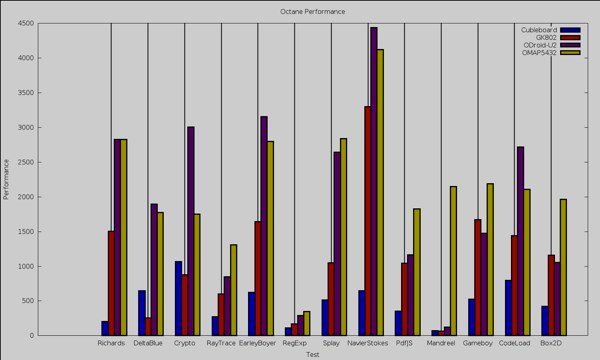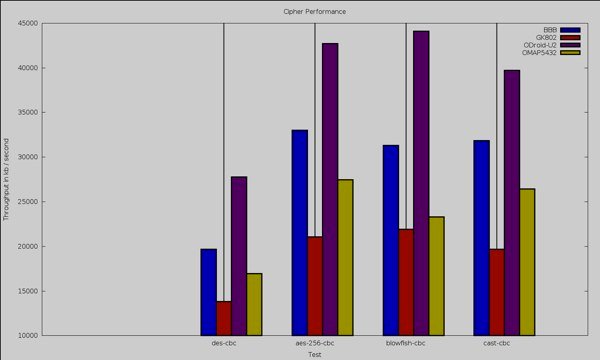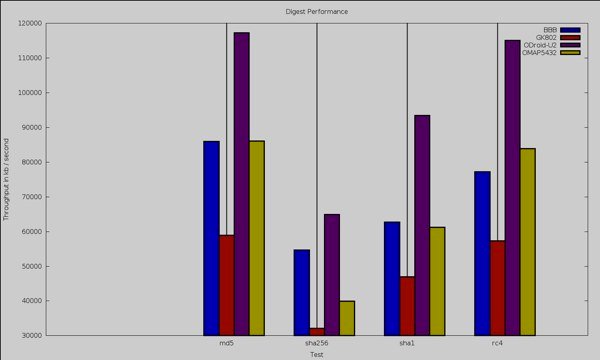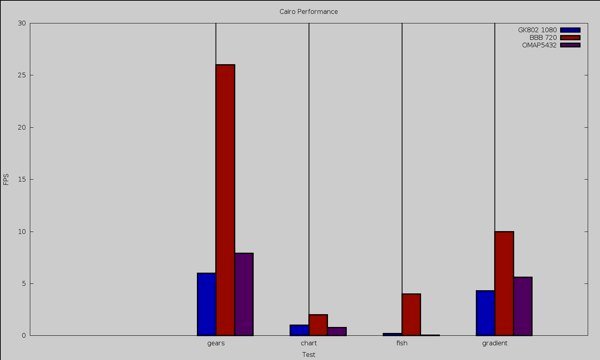Texas instruments and SVTronics announced an OMAP5 evaluation board a couple of months ago. The board features OMAP5432 dual Cortex A15, dual Cortex M4 SoC, 2GB RAM, a 4GB eMMC module, USB 3.0, SATA and more. SVTronics sent a board to Linux.com, where they wrote a short review, followed by an article benchmarking the OMAP5 EVM against AllWinner A10, Freescale i.MX6, Exynos 4412 Prime, and TI Sitara platforms, namely Cubieboard, GK802, ODROID-U2, and BeagleBone Black, all running Linux. Ben Martin, the writer, also benchmarked the board against a Linux PC powered by an Intel Core i7-2600K processor (4 cores, 8 thread, clocked at 3.4GHz, with a turbo frequency up to 3.8GHz).
The board used was an early version, clocked at 800MHz, and later in September, all boards will be clocked at 1.5Ghz, so for benchmarks that stress the CPU, you could expect almost double the performance. With that in mind, let’s have a look at the benchmarks and results.
Octane Benchmark
The Octane Benchmark measures a JavaScript engine’s performance, and it able to leverage multi-core configurations. Here are the results from lower to higher overall scores:
- ODROID-U2 – 1411
- OMAP5432 EVM – 1914
- Intel Core i7-2600K – 9667
Cubieboard and GK802 overall scores were not provided but you can see the different Octane test results for all 4 ARM targets in the chart below.
Despite having just 2 Cortex A15 cores @ 800 MHz, OMAP 5 EVM matches and in many cases, outperforms ODROID-XU with its 4 Cortex A9 Cores @ 1.7GHz. Mandreel tests are particularly interestingly, as OMAP5 appears to be much faster. This tests relies on WelGL so the GPU performance should also be taken into account, but probably does not explain the massive difference between OMAP5 and others.
Unsurprisingly, the Intel processor is way ahead with a score about 5 times greater. Once OMAP5 is clocked at 1.5GHz, the difference should only be 3x, which is actually less than I would have expected.
OpenSSL Benchmarks
The first test was to build OpenSSL natively. It took over 7 minutes on OMAP5432 EVM, over 8 minutes on GK802 mini PC, and about 1 minute and 30 seconds on an Intel 2600K CPU.
OpenSSL benchmark were then run on several hardware platforms for Ciphers (DES, AES, Blowfish, and Cast)
and Digests (MD5, SHA256, SHA1, and RC4).
ODROID-U2 is the fastest device in this particular test. The oddity is the BeagleBone Black (BBB) which can outperform the quad core i.MX6 in all tests, and Exynos 5 in some, with its Cortex A8 processor @ 1GHz. According to Ben, OpenSSL tests only use a single core. This can be part of the explanation, but I can also see Sitara AM355x processors support AES, SHA, and MD5 hardware acceleration, and it may have been implemented in openSSL.
2D Graphics Benchmarks with Cairo
Cairo Performance Demos version 1.0.1 were used to test 2D performance, and based on the test results OMAP5 has not been optimized just yet for this type of task, as the Beaglebone Black vastly outperform the OMAP5432 EVM. For some reasons, GK802 is not doing well either. We don’t know which Linux image was used for the test, and it could an GK802 image without 2D acceleration.
Storage Benchmarks (Flash and SATA)
Ben ran Bonnie++ to test both flash and SATA performance. Since the system has 2GB RAM and 4GB internal flash, caching strongly skewed the internal Flash read speed:
- Sequential output – 11.5MB/sec
- Sequential read – 496MB/sec
- 3270 seeks/sec.
Command line used:
|
1 |
bonnie++ -f -m omap5432flash -s 1000 -r 500 -n 0 -d `pwd` |
SATA benchmark performed with a 120GB Sandisk Extreme SSD with an EXT-4 partition are probably more interesting:
- Write speed – ~66MB/sec
- Read speed – ~131MB/sec
- 8558 seeks/sec
Command line:
|
1 |
bonnie++ -f -m omapsandisk120 -d `pwd` |
For reference, Hardkernel did a similar benchmark with ODROID-XU (Exynos 5410, 4x Quad A15, 4x Quad A7) but via a USB3 to SATA 3 adapter, and an OCZ’s Vertex3 128GB SSD. Instead of Bonnie++, they used dd with nocache flag, and found a write speed of 190 MB/S and a read speed of 150MB/s. Difference interface, different test method, and different SSD drive, so we should not compare these results directly, yet this still gives an idea of SSD performance on powerful ARM boards.

Jean-Luc started CNX Software in 2010 as a part-time endeavor, before quitting his job as a software engineering manager, and starting to write daily news, and reviews full time later in 2011.
Support CNX Software! Donate via cryptocurrencies, become a Patron on Patreon, or purchase goods on Amazon or Aliexpress









“… and an Intel Core i7-2600K based PC” made me giggle 😛
The OMAP5432 is the more interesting from its 5430 counter part, as it is not the PoP packaged one, so much more headroom for clocking/cooling.
Even though the CPU side looks fairly good, I wonder what kind of memory bandwidth (stream) figures it achieves, as it is supposed to have dual 32-bit DDR3 1066 that lacks compared to other modern ARM processors (i.MX6 has the same specs), let alone other Cortex-A15 SoCs.
And that SATA speed is pretty pathetic, maybe the same SSD should have a base reference figure benchmarked with the same software/config on some modern PC platform.
comparing imx6 @1080 with AM335x @720 what benchmark is this 🙂
> but I can also see Sitara AM355x processors support AES, SHA, and MD5 hardware acceleration,
> and it may have been implemented in openSSL.
Most those chips have acceleration for this – but you need to enable support and must be used by the software!
Next issue is the GK802 does not have any heatsinking (but would really need it) as everyone knows… worst platform for benchmarking, will most likely throttle down.
OMAP5 board has a heatsink and very large PCB for additional cooling.
BBB does not need a heatsink.
Plus:
> comparing imx6 @1080 with AM335x @720 what benchmark is this 🙂
2D acceleration may not be working properly on i.mx6 and surely not on the omap5 board.
Clearly this whole “benchmark” is pretty much useless.
I see newbies trying to do benchmarks everywhere these days 😉
@Tsvetan
I guess he took the path of least resistance… BBB image was 720p, i.MX6 image 1080p, and since changing the resolution may involve rebuilding the kernel… Anyway, this shows 2D accel is not available on OMAP5 yet.
It would have been extra nice if he had taken the same hardware platforms for all tests, and mentioned the Linux distribution and version used.
The GK802 doesn’t have NAND so performance could be attributed to the SD card being used. I found the BBB to be similar to a MK802+ if you want a simplistic Mini PC comparison (see https://plus.google.com/109451178006683865932/posts/6XUktH27fYZ). Perhaps using a SABRE Lite/Wandboard Quad (or even just a dual i.MX6 as cnxsoft says) instead of the GK802 might have been better for this comparison?
I would like to see the same test on this year cubieboard2, that’s strange to use one year old cubieboard, for a bench against this year boards… cubieboard1 use Cortex A8, so a VFP3lite, that is about ten times slower than the VPFv3, and still slower than the two VFPv4 included in dual cortex A7 from the Cubieboard 2 or Cortex A15 from the OMAP card. I suppose the difference will not be the same at all…
@onebir
This because the noise of the fan, the heat of the CPU, and the electricity bill (>100 W vs <5 W for the whole system) that you giggle, isn't it ;).
What a truly horrible quality of images. PNG man, have you heard of it?…
@Noloqoq
That too!
@Linuxium
1) You can seriously get a D2500 motherboard for $40 (=USD)? Not including processor & RAM I guess?
2) It’s pretty impressive how well the Odroid-U2 (with 2G RAM) compare with the D2500 with 4G… (& T428 to some extent).
3) Maybe someone could organise a group buy of a 4G RK3188 device??? (Perhaps on Indiegogo/Kickstarter?)
@onebir Intel D2500 motherboard costs under USD40 including processor here in AU. RAM and HDD are extra (but I had spares however for example 4GB 204pin SO-DIMM RAM costs around USD30 and 500GB 5,400 RPM HDD around USD50). Overall a full build adds up so my “lunch box” rig all in costs under $190 ($40 CPU/MOBO $50.00 PSU USD30 RAM $50 HDD $10 “CASE” & $10 NYLON SPACER/SCREWS) – works though, is faster than I expected, and is the coolest lunch box in the office! Re 4G RK3188 device I’ve been asking but nobody wants to bite – from reseller, distributor to manufacturer – just makes me think there is only one hut on the banks of the Pearl river knocking out these sticks!
@Linuxium
Hmm, they’re >=$85 on AliExpress; I think with processor & RAM; I guess RAM & shipping make the difference (?)
Re 4GB RK3188, couldn’t any factory (/hut :p) do a run of X 4GB variants??? Anyone got any ideas what X might be, at minimum?
@onebir
Most likely the RK3188 chip cannot support 4GB but only 2GB as 2x1GB max.
@Linuxium
I’m not sure; we’ve seen some sellers offer 4GB RAM variant to batch purchasers, see latest comments here:
http://www.cnx-software.com/2013/06/09/rockchip-rk3188-based-qc802-mini-pc-can-now-be-purchased-for-65/
But maybe this was in error?
@onebir
According to TRM RK3188 chip cannot support 4GB – so its six of one and …
They’ve done similar benchmark with ODROID-XU, IFC6410…: http://www.linux.com/learn/tutorials/752860-benchmarking-the-odroid-xu-a-fast-clocked-quad-a15-arm-machine